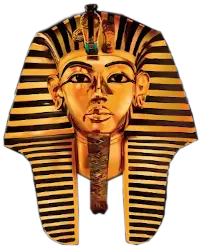
VI. The Chariot was not a culture pattern of the Greeks, at the time of Plato, nor was it used by them in warfare:--
Greek culture and traditions did not furnish Plato with the idea of the chariot and winged steeds, for nowhere in their brief military history, (i.e., up to the time of Plato) do we find the use of such a war machine by the Greeks.
The only nearby nation who specialized in the manufacture of chariots and the breeding of horses was the Egyptians. When Joseph was Governor in Egypt, the horse and war chariot were in use; and when the Israelites fled from the country, Pharaoh pursued them to the Red Sea in chariots. Even Homer and Diodorus who visited Egypt, testify that they saw a great multitude of war chariots and numerous stables along the banks of the Nile, from Memphis to Thebes.
And since the Judgment Drama in the Egyptian Book of the Dead reveals the entire philosophy contained in the allegory, Plato cannot be credited as its author.
The following sketch of the military history of the Greeks shows that the chariot was not used by them, nor was it their culture pattern:--
A. wars or wars with the Persians.
(a) The Ionian revolt against Persian rule, 499-494 B.C. This climaxed in a naval engagement at Lade, where the Ionian fleet was defeated.
(b) The of Marathon, 490 B.C.
During the summer of 490 B.C., the Greeks met the Persians at the bay of Marathon, and after a brief fight with bows and arrows, both belligerents withdrew to prepare for more decisive engagements.
(c) The battle of Thermopylae, 480 B.C.
Ten years after Marathon, the Persians and Greeks met again to settle their grievances. The Persians anchored in the Gulf of Pagasae, while the Greeks anchored off Cape Artimesium. A battle followed and Thermopylae was captured by the Persians.
Topics
Greek Philospohy is Stolen Egyptian Philosophy
The Memphite Theology is the Basis of all Important Doctrines of Greek Philosophy
Greek Philosophy was Alien to the Greeks
Greek Philosophy was the offspring of the Egyptian Mystery System
The Egyptians Educated the Greeks
The Curriculum of the Egyptian Mystery System
The Pre-Socratic Philosophers and the teaching Ascribed to them
The Athenian Philosophers
1. Socrates
2. Plato
3. Aristotle